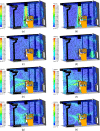Local ventilation effectiveness dependence on the airflow pattern and temperature in the case of isothermal balanced ventilation
- PMID: 40478026
- PMCID: PMC9514964
- DOI: 10.1016/j.jobe.2022.105309
Local ventilation effectiveness dependence on the airflow pattern and temperature in the case of isothermal balanced ventilation
Abstract
Appropriate ventilation may help in the mitigation of airborne transmission of viruses in buildings. Before the COVID-19 pandemic, the ventilation rate was determined depending on the number of occupants, net floor area, and building pollution category. Increasing the ventilation rate, the risk of cross infections may be reduced substantially. Ventilation effectiveness provides information about the airflow capacity to remove the pollutants from the breathing zone of occupants. In the present study, the interrelation between ventilation effectiveness and the air temperature was analysed in the case of different isothermal balanced ventilation strategies. Mixing, displacement, and personalized ventilation were investigated in a test room, measuring the CO2 concentration, and having the air exhaust positions above the floor and under the ceiling. The air temperatures were set between 21 °C and 26 °C. To illustrate the airflow patterns numerical simulations have been carried out. It was shown that there are significant differences between ventilation effectiveness depending on the air temperature and ventilation strategy. In most cases, the ventilation effectiveness was higher when the air exhaust was positioned under the ceiling. For investigated air temperatures, differences of even 20%-40% have been determined between ventilation effectiveness values in the case of a certain ventilation strategy.
Keywords: Airborne transmission; CO2 concentration; COVID-19; Ventilation effectiveness; Ventilation strategy.
© 2022 The Authors.
Conflict of interest statement
The authors declare that they have no known competing financial interests or personal relationships that could have appeared to influence the work reported in this paper.
Figures

















Similar articles
-
Air cleaning technologies: an evidence-based analysis.Ont Health Technol Assess Ser. 2005;5(17):1-52. Epub 2005 Nov 1. Ont Health Technol Assess Ser. 2005. PMID: 23074468 Free PMC article.
-
Assessing Effectiveness of Ceiling-Ventilated Mock Airborne Infection Isolation Room in Preventing Hospital-Acquired Influenza Transmission to Health Care Workers.ASHRAE Trans. 2016;122(2):35-46. ASHRAE Trans. 2016. PMID: 28529344 Free PMC article.
-
Removal of contaminants released from room surfaces by displacement and mixing ventilation: modeling and validation.Indoor Air. 2005 Oct;15(5):367-80. doi: 10.1111/j.1600-0668.2005.00383.x. Indoor Air. 2005. PMID: 16108910
-
Personalized ventilation.Indoor Air. 2004;14 Suppl 7:157-67. doi: 10.1111/j.1600-0668.2004.00284.x. Indoor Air. 2004. PMID: 15330783 Review.
-
Carbon dioxide guidelines for indoor air quality: a review.J Expo Sci Environ Epidemiol. 2024 Jul;34(4):555-569. doi: 10.1038/s41370-024-00694-7. Epub 2024 Jun 13. J Expo Sci Environ Epidemiol. 2024. PMID: 38871958 Review.
References
-
- Lidia M., Tang Julian W., Bahnfleth W., Bluyssen M., Boerstra A., Buonanno G., Cao J., Dancer S., Floto A., Franchimon F., Haworth C., Hogeling J., Isaxon Ch, Jimenez J.L., Kurnitski J., Li Y., Loomans M., Marks G., Marr L.C., Mazzarella L., Melikov A.K., Miller S., Milton D.K., Nazaroff W., Nielsen P.V., Noakes C., Peccia J., Querol X., Sekhar C., Seppänen O., Tanabe S., Tellier R., Tham K.W., Wargocki P., Wierzbicka A., Yao M. How can airborne transmission of COVID-19 indoors be minimised? Environ. Int. 2020;142 - PMC - PubMed
-
- Kalmar T., Szodrai F., Kalmar F. Experimental study of local effectiveness in the case of balanced mechanical ventilation in small offices. Energy. 2022;244
LinkOut - more resources
Full Text Sources
